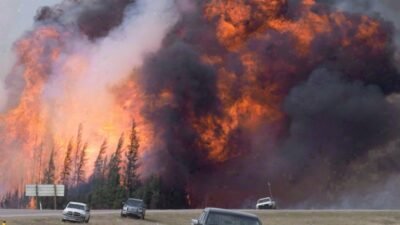As smoke travels south and hovers over most of the Northeast this week, wildfires burning in Canada have caused hazardous air quality conditions in the United States. What is climate change’s role in the Canada wildfires?
However, witnessing them on the opposite side of the country has raised concerns about how big of a role climate change is playing in the event. Wildfires in California and other western states have already caused air quality advisories.
Why is Canada’s wildfire season so bad this year?
The wildfire season has gotten off to an incredible and exceptionally early start in Canada, burning more than 1400% of the typical number of acres at this time of year.
2023 saw the burning of more than 8.7 million acres in Canada, an amount larger than the state of Vermont. Nearly 6.2 million acres in Canada will burn due to wildfires in an average fire season.
The United States and Canada have been in what is known as an “omega block” for about a month; it has broken down a few times, but just for a moment or two.
This has allowed persistent heat for Central Canada and The Great Lakes — and short surges of record heat for eastern Canada around Montréal and Nova Scotia.
What’s the connection between climate change and wildfires?
Climate change does not cause wildfires; instead, they are a result of Earth’s natural cycles and are increasingly being ignited by people, either on purpose or by mistake.
The National Park Service claims that Humans are responsible for starting 85% of wildfires in the United States, sometimes on purpose and more often by mistake. About half of the fires in Canada this year, according to the country, were sparked by people.
However, heat and drought, two factors that contribute to wildfire intensity and severity, are directly related to anthropogenic climate change.
According to Canada’s Natural Resources Agency, climate change may cause the amount of land to burn by the end of the century to quadruple, with significant economic repercussions including a reduction in the supply of timber and changes in the kind of trees that make up the bulk of forests.
The amount of fuel for forest fires can also be increased by damaged trees, dead trees, dead brush in the forests, or invasive insects.
What is climate change’s role in the Canada wildfires?
This week, air quality alerts have been issued for the Northeastern United States and other regions of the nation due to the wildfires in Canada.
Due to changes in rainfall and weather patterns that might increase the number of pollutants like ozone or particulates like smoke that persist close to the ground, climate change is predicted to worsen air pollution conditions.
According to preliminary studies, warming global temperatures may weaken the jet stream’s flow, causing air to stagnate for long periods of time.
The existence of the jetstream is due to the significant temperature differential between the equator and the poles. Wintertime temperature gradients in the northern hemisphere lead the jet to be stronger. The jet is weaker in the summer.
Today, we see global temperatures rising overall, but the Arctic and poles are warming 2-3 times faster than anywhere else. That means there is less temperature difference and scientists believe this may cause the jet to be weaker in all seasons.
The nonprofit organization Climate Central found that of 241 U.S. cities, 83% have seen an increase in the number of stagnant air days since 1973.
More than 100 million Americans live in communities with air pollution levels that are above what is deemed healthy, according to the Fourth National Climate Assessment, which was published in 2018. The assessment also found that climate change and more frequent, intense wildfires will make this air pollution worse.
However, taking measures to slow down global warming, such as cutting back on greenhouse gas emissions, can lessen those effects by cutting back on both future heat and air pollution.
Also read: Climate change in Pakistan: Understanding its impacts and urgent call for action
